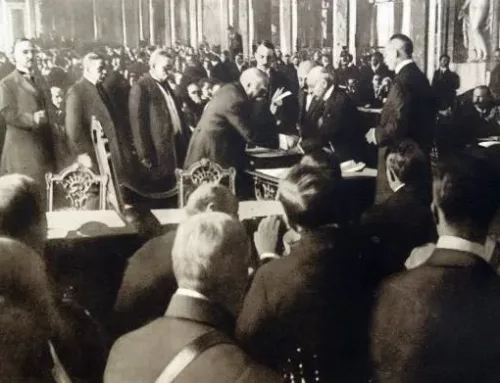The Gramophone Goes to War
Published: 1 September 2022

cylinder_phonograph
Cylinder phonograph
The advent of recording paralleled the development of radio. Though Thomas Edison considered his invention as a dictation machine in 1888, businesses saw the commercial possibilities of the cylinder phonograph as an entertainment device. Columbia marketed the product and from 1890 onward, it was considered easy to purchase records. This ease of accessibility would be facilitated when the gramophone, which played 78-rpm flat-discs, replaced the cylinder phonograph. These discs were easier to mass-produce. During the war, the “big three” firms producing recordings in the United States were Edison, Victor, and Columbia. The United Kingdom also had their own firms: Decca and Gramophone.9 At the home front, music lovers equipped their parlors with a piano, a library of sheet music and a mechanical playback device such as a gramophone. Song production at Tin Pan Alley was booming at this time. It is not surprising that the war years were the heyday of sound production entrepreneurs. Craig Roell provides interesting figures:
By 1914 more than 500,000 phonographs were being produced each year, with a value of $27 million. But in 1914, a record 323,00 pianos were also produced, value at $56 million. Piano manufacturers, who were selling unprecedented numbers of pianos, were hardly worried by the possible threat of competition.10
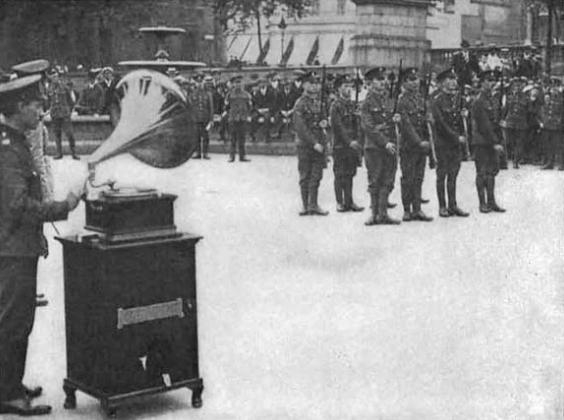
A Gramophone commands troops
By 1915, the phonograph was used in the British military to instill patriotism in volunteers and as a recruiting device. A surviving picture shows a gramophone being used to command soldiers at a display drill. Similarly, due to the shortage of instructors, a photo taken from late 1917 at the U.S. Naval Training Station at the Dunwoody Industrial Institute in Minneapolis shows a phonograph teaching recruits basics of wireless telephony.11 By 1915, British soldiers were also bringing portable gramophones to the front for entertainment and solace in the trenches. An advertisement from Decca attests that it was “light, compact, and portable” with the header reading “A Gift from Home!” Similarly, the Edison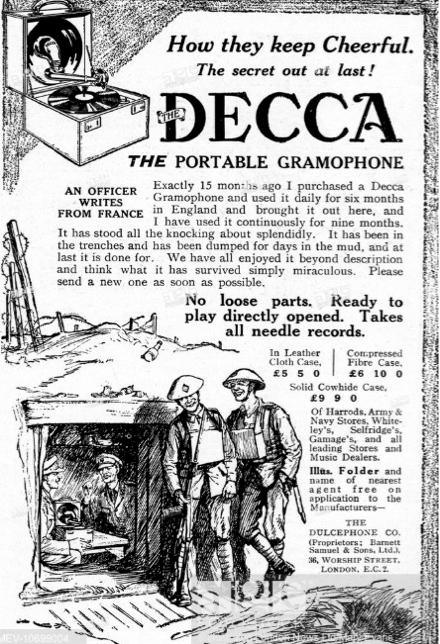
An issue of the Independent-Harper’s Weekly from October 28, 1918 describes the gramophone as a cherished companion of soldiers and sailors, playing a few records from home repeatedly to alleviate boredom and terror. Indeed, demand for records was 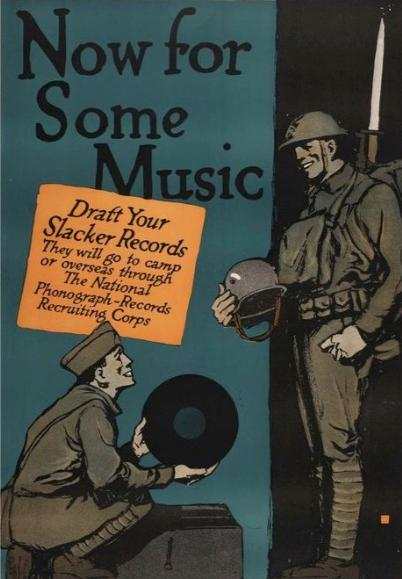
Available recordings of WWI songs today
Commenting on Siegfried Sassoon’s poem Dead Musicians III, Watkins writes: … “the phonograph was capable of momentarily recapturing or, more properly, of forever “freezing” the memories of former buddies. But when the recording came to its conclusion, breaking off with the swooshing sound of a needle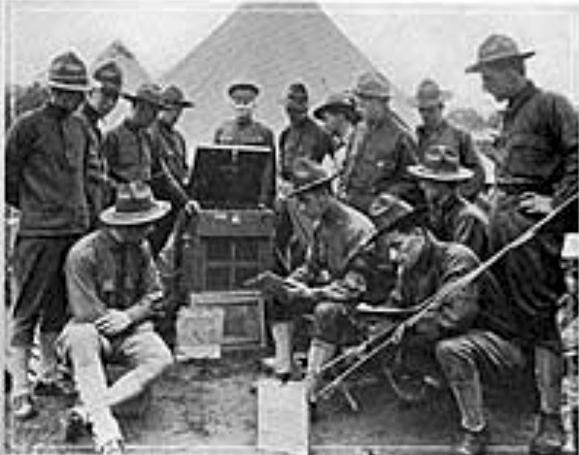
A century has already passed since the Armistice, but thanks to the development of sound recording. We still have access to the same recordings of the songs that provided courage to the soldiers heading off across the Atlantic, songs that offered diversion to the soldier in the trenches, and songs that offered solace to those left at home or lost a loved one.
Many of the phonographs that were recorded during the war are already digitized and can be accessed online. As of 2019, here are some links:
1. Archive.org https://archive.org/details/SONGSOFWORLDWARI-NewTransfer
2. Cylinder Preservation and Digitization Project at the University of California, Santa Barbara http://cylinders.library.ucsb.edu/
3. Library of Congress https://www.loc.gov/audio/?fa=subject%3Aworld+war&dates=1910-1920
4. FirstWorldWar.com https://www.firstworldwar.com/audio/
A 12-CD set entitled World War One Songs Early Recordings from 1918 Victrola is also available. The recordings were produced by “…a 1918 hand cranked Victrola using special equipment to enhance and retain the characteristic Victrola sound.”14
Notes:
9. Druesedow, p. 365
10. Roell, p. 48
11. More information for this topic can be found here: https: Dan Schlenoff “The Phonograph Goes to War, 1915” //blogs.scientificamerican.com/anecdotes-from-the-archive/the-phonograph-goes-to-war-1915/
12. LC article: History of the Edison Disc Phonograph https://www.loc.gov/collections/edison-company-motion-pictures-and-sound-recordings/articles-and-essays/history-of-edison-sound-recordings/history-of-the-edison-disc-phonograph/
13. Watkins, pp. 380-381
14. See http://www.besmark.com/ww1bhtml.


